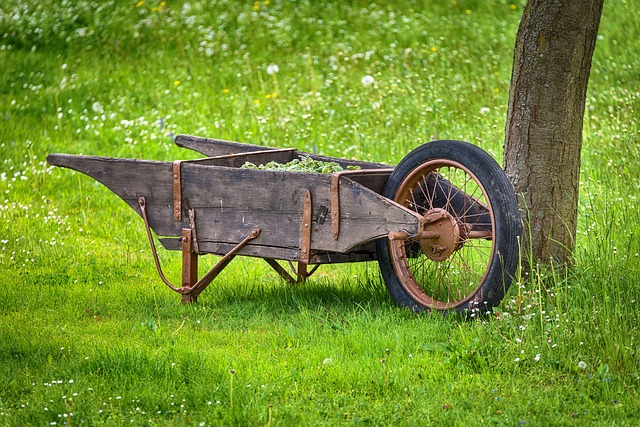The number of wheelbarrows in a ton depends on the weight capacity of the wheelbarrow and the material being loaded. A standard wheelbarrow holds about 2 to 3 cubic feet of material, which can weigh around 100 to 200 pounds. Since a ton is 2,000 pounds, you might fit approximately 10 to 20 wheelbarrows of material weighing around 100 pounds each.
However, for denser materials like gravel or sand, which can weigh more, you might have fewer wheelbarrows in a ton.
How do you calculate the wheelbarrow?

Calculating a wheelbarrow’s capacity means finding its volume, often in cubic feet or cubic meters. It’s the maximum material it holds when filled to the top. The steps are as follows:
1. Measurements
For an accurate wheelbarrow capacity calculation, measure its interior length, width, and depth in inches or centimeters. Ensure measurements capture the widest points and any shape variations. As an illustration, a sample wheelbarrow could have dimensions like Length – 48 inches, Width – 32 inches, and Depth – 14 inches.
2. Convert Measurements (if necessary)
If your measurements are inches, divide them by 12 to convert them to feet. For metric (centimeters), divide by 100 to convert to meters.
3. Calculate Volume
After obtaining the measurements, calculate the volume using the formula: Volume = Length x Width x Depth. Multiply these dimensions in the same units (inches or centimeters) for the volume in cubic units. For example, if Length = 48 inches, Width = 32 inches, and Depth = 14 inches, the volume is 21,504 cubic inches.
4. Optional: Convert Units (if necessary)
If you want to express the volume in a different unit, make the necessary conversions. For instance, convert cubic feet to liters or cubic meters to gallons, based on your preference.
The above steps may vary depending on the wheelbarrow’s shape and size. If the wheelbarrow is not rectangular, you may need to use more difficult mathematical procedures or break it into simpler shapes to compute volume.
For example, suppose a wheelbarrow has these dimensions:
Length: 3 feet
Width: 2 feet
Depth: 1.5 feet
The volume can be determined as follows:
Volume = Length × Width × Depth
Volume = 9 cubic feet (3 x 2 x 1.5 ft).
Therefore, this wheelbarrow holds 9 cubic feet of material.
5. Rounding
Round the calculated volume to an appropriate level of accuracy based on your measurements. For example, if you measured in whole inches, your volume calculation might be large. Rounding to a few decimal places could provide a more manageable figure.
How to use wheelbarrows in measurements?
Using wheelbarrows for measurements is a practical approach for estimating quantities of materials like soil, gravel, or mulch. Here’s a step-by-step guide on how to effectively use wheelbarrows for measurements:
1. Choose the Right Wheelbarrow
Select a wheelbarrow that suits the type of material you’ll be measuring. Consider factors like size, capacity, and durability. A sturdy wheelbarrow with proper weight distribution will provide accurate measurements.
2. Prepare the Wheelbarrow
Place the wheelbarrow on a flat and level surface. Ensure the interior is clean and debris-free to prevent inaccurate measurements.
3. Load the Material
Gently load the material into the wheelbarrow using a shovel or scoop. Be careful to fill the material appropriately, which can affect the measurement accuracy. Fill the wheelbarrow evenly without creating a heap.
4. Level the Material
Once the wheelbarrow is loaded, use a flatboard or a straight-edged tool to level off the material. The top of the material should be even with the sides of the wheelbarrow for accurate measurements.
5. Measure Depth, Length, and Width
Use a measuring tape or ruler to measure the depth, length, and width of the material in the wheelbarrow. Measure from the leveled surface to the top of the material for depth. Measure the longest and widest parts for length and width.
6. Calculate Volume
For a rectangular wheelbarrow, calculate the volume using the formula: Volume = Length x Width x Depth. Multiply the measurements in the same units (inches, feet, centimeters, meters) to get the volume in cubic units.
7. Conversion and Weight Measurement (Optional)
If necessary, convert measurements to a consistent unit of measurement. To measure weight, you’ll need to know the material’s density. Calculate weight by multiplying volume with density.
8. Repeat for Accuracy
For more accurate measurements, repeat the process several times and calculate the average. This helps compensate for any irregularities in wheelbarrow shape or material distribution.
9. Consider Material Density
Different materials have varying densities, affecting how much they weigh in a wheelbarrow. For more accurate estimates, know the density of the material you’re measuring.
10. Record Measurements
Keep a record of your measurements, calculations, and any conversion factors used. This documentation will be useful for future reference or when planning projects.
11. Compare with Other Measurements
Use other measurement methods, like standard containers or scales, to cross-check the accuracy of your wheelbarrow measurements. This can help ensure reliability.
12. Practice and Experience
With practice, you’ll become more adept at estimating and using wheelbarrows effectively for measurements. Over time, you’ll develop a better understanding of how different materials fill the wheelbarrow and how to interpret your measurements.
13. Adjust for Accuracy
Recognize that wheelbarrow dimensions can vary, impacting measurements. Adjust your approach based on the shape, size, and construction of the wheelbarrow.
Remember, while using wheelbarrows for measurements is convenient, it’s suitable for projects where precision is not critical. For tasks requiring greater accuracy, consider using standardized measuring tools and methods. Your familiarity with wheelbarrow measurements will become a valuable skill in construction, landscaping, and gardening projects.
Volume and capacity of wheelbarrow: how much it can hold

A wheelbarrow’s volume and capacity indicate how much space it can hold. In most cases, the capacity is stated in terms of volume, such as cubic feet or cubic meters. Here is a list of various wheelbarrow kinds, along with an estimate of their volume capacities:
| Type of wheelbarrow | Volume capacity |
| Standard | 2 to 6 cubic feet |
| Large/Dual-Wheel | 6 to 10 cubic feet |
| Contractor/Heavy Duty | 8 to 12 cubic feet |
| Garden/Collapsible | 1 to 3 cubic feet |
These volume capacities offer an approximate idea of a wheelbarrow’s material-holding ability according to its design and purpose. Note that actual capacity can differ due to model and manufacturer variations.
How many wheelbarrow loads are in 1 ton of gravel?
The number of wheelbarrow loads required to transport 1 ton of gravel depends on the volume capacity of the wheelbarrow and the Density of the gravel. Let’s break down the calculation:
1. Determine Density
Find out the Density of the gravel. Gravel has a wide range of densities, but for the purposes of this example, let’s suppose one of 1600 kg/m3 (or 100 lb/ft3).
2. Convert Units (if necessary)
Make sure the density unit matches the unit of volume capacity of the wheelbarrow (cubic meters or cubic feet).
3. Calculate the Volume of 1 Ton of Gravel
Divide the weight (1 ton) by the Density of the gravel.
4. Calculate the Number of Wheelbarrow Loads
Divide the volume of one wheelbarrow by the volume of 1 ton of gravel.
Remember that the number of wheelbarrow loads will vary depending on the Density of the gravel and the size of the wheelbarrow. Here’s a simplified example using the assumed Density:
The assumed Density of gravel: 1600 kg/m³ (100 lb/ft³)
Assumed wheelbarrow capacity:0.1 cubic meters (3.5 cubic feet)
Volume of 1 ton of gravel = 1 ton / 1600 kg/m³ = 0.000625 m³ (or approximately 0.022 cubic feet)
Number of Wheelbarrow Loads= Volume of 1 ton of gravel / Wheelbarrow capacity
Number of Wheelbarrow Loads= 0.000625 m³ / 0.1 m³ = 0.00625 loads
According to these assumptions, 1 ton of gravel may be moved with around 0.00625 (or roughly 1/6) of a wheelbarrow load. It’s vital to remember that these figures are based on the given assumptions and that real results might vary.
How many wheelbarrows are in a ton of river rock?
The volume capacity of the wheelbarrow and the Density of the river rock determine how many wheelbarrows are required to transport a ton of river rock. Use this formula to determine the amount:
Number of Wheelbarrow Loads = Weight of River Rock (in tons) / Volume Capacity of Wheelbarrow (in tons)
- Determine Density
Find out the Density of the river rock. River rock densities can vary widely, but for estimation purposes, let’s assume a density of 1.25 tons per cubic yard.
- Convert Units (if necessary)
Ensure the Density is in the same units as the volume capacity of the wheelbarrow.
- Calculate the Number of Wheelbarrow Loads
Divide the weight of 1 ton of river rock by the volume capacity of a single wheelbarrow.
Using the assumed Density of 1.25 tons per cubic yard and a typical wheelbarrow volume capacity of 0.1 cubic yards:
Number of Wheelbarrow Loads = 1 ton / 1.25 tons/yd³ / 0.1 yd³ = 8 wheelbarrow loads
So, based on these assumptions, you would need around 8 wheelbarrow loads of river rock to transport 1 ton, given the assumed Density and wheelbarrow capacity. Actual values can vary based on the specific Density of the river rock and the size of the wheelbarrow.
FAQs
What is the weight of one wheelbarrow in a ton?
A wheelbarrow’s weight might vary based on how it was made and what materials were used. On average, a typical wheelbarrow may weigh between 25 and 50 pounds (11 and 23 kilograms). When converted to tons, this weight corresponds to approximately 0.0125 to 0.025 tons.
How big is a 1-ton pile of gravel?
The Density of the gravel determines the size of a 1-ton pile. In the case of gravel, where the Density is about 1.25 tons per cubic yard, a pile weighing 1 ton would have a volume of about 0.8 cubic yards. At a depth of 1 inch, this would cover an area of around 80 square feet.
Final verdict
In conclusion, this article deeply explores the correlation between wheelbarrows and tonnage, accounting for material density and capacity. For instance, a 0.1 cubic yard wheelbarrow with gravel’s 1.25 tons per cubic yard density equals around 8 loads per ton. It provides calculations, insights, and practical understanding. Considering various wheelbarrow sizes’ impact on measurements, assess capacity beforehand. Dive into valuable insights and anticipate more enlightening guides.
Remember, understanding wheelbarrow capacity and material density nuances is crucial for estimating loads accurately. Choose the right wheelbarrow, measure and calculate loads effectively, and account for variations. This guide ensures efficiency in your projects.









